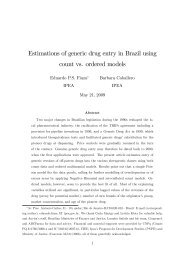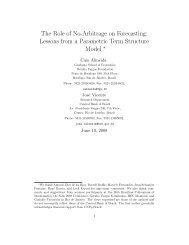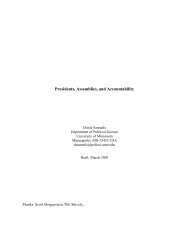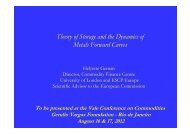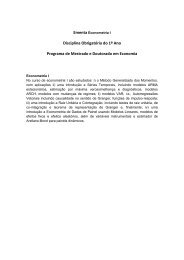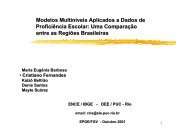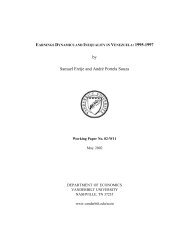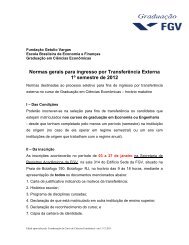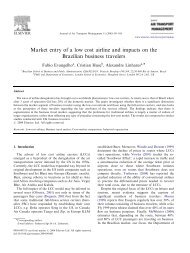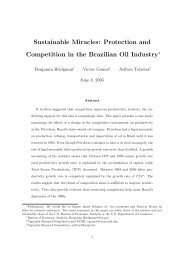Does Money in Schools Matter? Evaluating the Effects ... - EPGE/FGV
Does Money in Schools Matter? Evaluating the Effects ... - EPGE/FGV
Does Money in Schools Matter? Evaluating the Effects ... - EPGE/FGV
Create successful ePaper yourself
Turn your PDF publications into a flip-book with our unique Google optimized e-Paper software.
Therefore, <strong>the</strong> impact of FUNDEF on <strong>the</strong> schools and on teachers’ wages <strong>in</strong> a<br />
municipality or state depended on <strong>the</strong> amount of resources <strong>in</strong>itially allocated to <strong>the</strong><br />
fundamental education system out of its education budget; on <strong>the</strong> <strong>in</strong>itial share of wages out<br />
of this amount and on its share of enrollments as compared to its share of revenues with<strong>in</strong><br />
<strong>the</strong> State.<br />
Table 1 reports <strong>the</strong> f<strong>in</strong>ancial redistribution that took place between <strong>the</strong> each state<br />
and its municipalities <strong>in</strong> 1998 for <strong>the</strong> different regions. The transfers with<strong>in</strong> a State would<br />
sum zero, were it not for <strong>the</strong> federal government transfers that complement <strong>the</strong> budget if <strong>the</strong><br />
expenditures per student do not reach <strong>the</strong> m<strong>in</strong>imum amount. It is clear that <strong>in</strong> all regions,<br />
with <strong>the</strong> exception of <strong>the</strong> south-east (SE), <strong>the</strong> transfer favored <strong>the</strong> municipalities. This<br />
happened because <strong>the</strong>ir proportion of enrolments was high relative to <strong>the</strong> proportion of <strong>the</strong>ir<br />
revenues.<br />
Figure 2 shows <strong>the</strong> behavior <strong>the</strong> expenditures on education <strong>in</strong> each state as a<br />
proportion of <strong>the</strong> GDP over time. S<strong>in</strong>ce <strong>the</strong> proportion of <strong>the</strong> revenues spent on education<br />
<strong>in</strong> each unit should be constant over time (determ<strong>in</strong>ed by <strong>the</strong> Constitution), <strong>the</strong> changes <strong>in</strong><br />
<strong>the</strong> share of education expenditures should correspond to changes <strong>in</strong> <strong>the</strong> revenues/GDP<br />
ration. It is clear that <strong>the</strong>re was a rise <strong>in</strong> <strong>the</strong> share of education expenditures <strong>in</strong> <strong>the</strong> country<br />
as a whole between 1997 and 1998, with <strong>the</strong> ma<strong>in</strong> responsible be<strong>in</strong>g <strong>the</strong> states and<br />
municipalities of <strong>the</strong> Nor<strong>the</strong>ast, where <strong>the</strong> rise actually start<strong>in</strong>g <strong>in</strong> 1997. Therefore, a higher<br />
share of resources was be<strong>in</strong>g spent on education over <strong>the</strong> period under analysis.<br />
FUNDEF established that 60% of all education resources should be spent on<br />
fundamental education. Figure 3 shows that <strong>the</strong> states were, on average, already spend<strong>in</strong>g<br />
more than 60% of its education resources on fundamental education <strong>in</strong> 1997. This is also<br />
true for each state and municipal system separately, except for <strong>the</strong> state system <strong>in</strong> Sao




